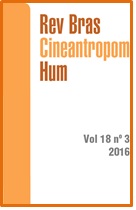Time-course of changes in indirect markers of muscle damage responses following a 130-km cycling race
DOI:
https://doi.org/10.1590/1980-0037.2016v18n3p322Abstract
The purpose of the present investigation was to identify the effects of a 130-km cycling race on indices of biochemical indirect markers of muscle damage and muscle soreness responses during a 72-hour recovery period. Fifteen endurance-trained male cyclists which were competing for more than 2 years and were involved in systematic training at least of 3 days/wk underwent a collection of indirect biochemical markers of muscle damage (CK, LDH, Myo) and delayed onset of muscle soreness (DOMS), at five different moments of data collection: before (PRE) and immediately after (POST) a 130-km cycling race, and 24, 48, 72 hours following the cycling race. CK and LDH plasma concentrations significantly increased POST-race (p < 0.001) and remained high throughout the 72 hour recover period (CK: p < 0.05; LDH: p < 0.001). Myo increased significantly POST-race (p < 0.001) and returned to the PRE-race values 24 hours thereafter (p < 0.05). DOMS increased significantly POST-race (p < 0.001) and returned to the PRE-race values at 48 hours after (p > 0.05). A 130-km cycling race has a noteworty effect on indices of biochemical indirect markers of muscle damage and muscle soreness responses, indicating that 72 hour recovery period do not seems to be enough for long-distance cyclist, and reinforce the propositions of scientific literature about the need of a sufficient recovery period for cycling endurance athletes.



